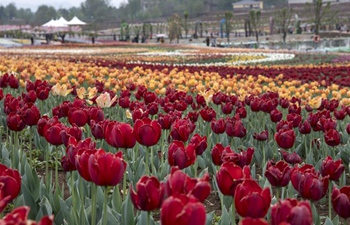FUZHOU, April 25 (Xinhua) -- Holding a bunch of bamboo sticks in his hands, Pu Lianggong, 65, dips them into a jar of water, flips and rolls them in a basket of incense powder to coat every piece evenly.
He eventually casts them on the floor to dry in the sun. The sticks fan out like a blooming flower.
Pu spends most of his life studying and making incense in his old workshop, a one-roof shed with walls of rammed earth in Yongchun county of Quanzhou, a city in eastern China's Fujian Province.
Despite the long hours and labor required, the adept craftsman never gets tired of making incense, a handicraft that originated from his Arab ancestors who traded spices along the ancient Marine Silk Road centuries ago.
ARAB ORIGIN
Producing a faded family tree booklet from an archaic cupboard, the craftsman is proud to trace his lineage back to Pu Shougeng, an Arab trader appointed as a high-ranking official of Quanzhou during the late Song and early Yuan dynasties in the second half of the 13th century.
For over three decades, Pu's family controlled the shipping trade of spices, one of the most prevalent products in Quanzhou.
From the 11th to the 14th century, the city grew into the largest settlement of Arabs and Persians in the Far East. Some of them took root and never moved, married local Chinese, and became part of the local community.
In 1646, Pu Shimao, one of Pu Shougeng's descendants fled to Hankou village in the mountainous county of Yongchun to escape war and turmoil in Quanzhou, bringing with him traditional Arabic incense making skills.
His arrival gave birth to the incense industry in the remote village where the family makes and trades incense for a living. The Pu family shared their unique techniques with fellow villagers, opening the history of incense making in Yongchun as the industry flourished and spread throughout the county.
The industry reached its heyday in the 1930s when Pu Shuli, Pu Lianggong's grandfather, opened a store by a wharf in a suburb of Yongchun and managed to expand his business to Southeast Asia and Japan through the port of Quanzhou.
Pu Shuli also sent his son to Vietnam to set up a branch and purchase local aromatics for the main store, and then sold their products to southeastern Asian countries, Japan, and Europe.
Today, there are about 300 incense manufacturers in Yongchun, with more than 30,000 people working in the industry. It is said that one in every three incense sticks sold in Southeast Asia is made in Yongchun.
Like their maritime trader forefathers, the Pu family and other villagers endeavor to revive the trade of scent brought by their Arab ancestors.
A GENERATIONAL TRADE
As a family tradition, Pu Lianggong, at the age of five, started to learn to recognize hundreds of kinds of spices, and was taught the ancient technique of making incense when he was nine.
"I had to master all 18 procedures of the ancient craft, which was both boring and arduous," said Pu, who used to practice for an hour every day after school.
At the age of 14, he mastered all the skills of incense making, and at 24, he took over the family business.
"We need to combine dozens of spices and herbs to make incense for different seasons and purposes," said Pu. "It might take two or three generations to develop a product of classic quality."
The family is promoting the incense culture to younger generations. Pu Haixing, son of Pu Lianggong, set up an incense-making course at a vocational school in Quanzhou.
"Incense is mainly used for religious occasions now, but only a few people realize that burning incense can help people relax and sleep well," said Pu Haixing. "I hope more people can get to know and appreciate the incense culture."
At present, the Pu family and other incense companies are selling hand-made incense to Southeast Asia and Europe online, strengthening business ties with customers from over 10 countries along the Belt and Road.
Pu Lianggong is happy to see his 10-year-old granddaughter, Pu Qi'nan, named after a rare type of premium eaglewood as a family tradition, was able to identify 30 types of spices when blindfolded.

















